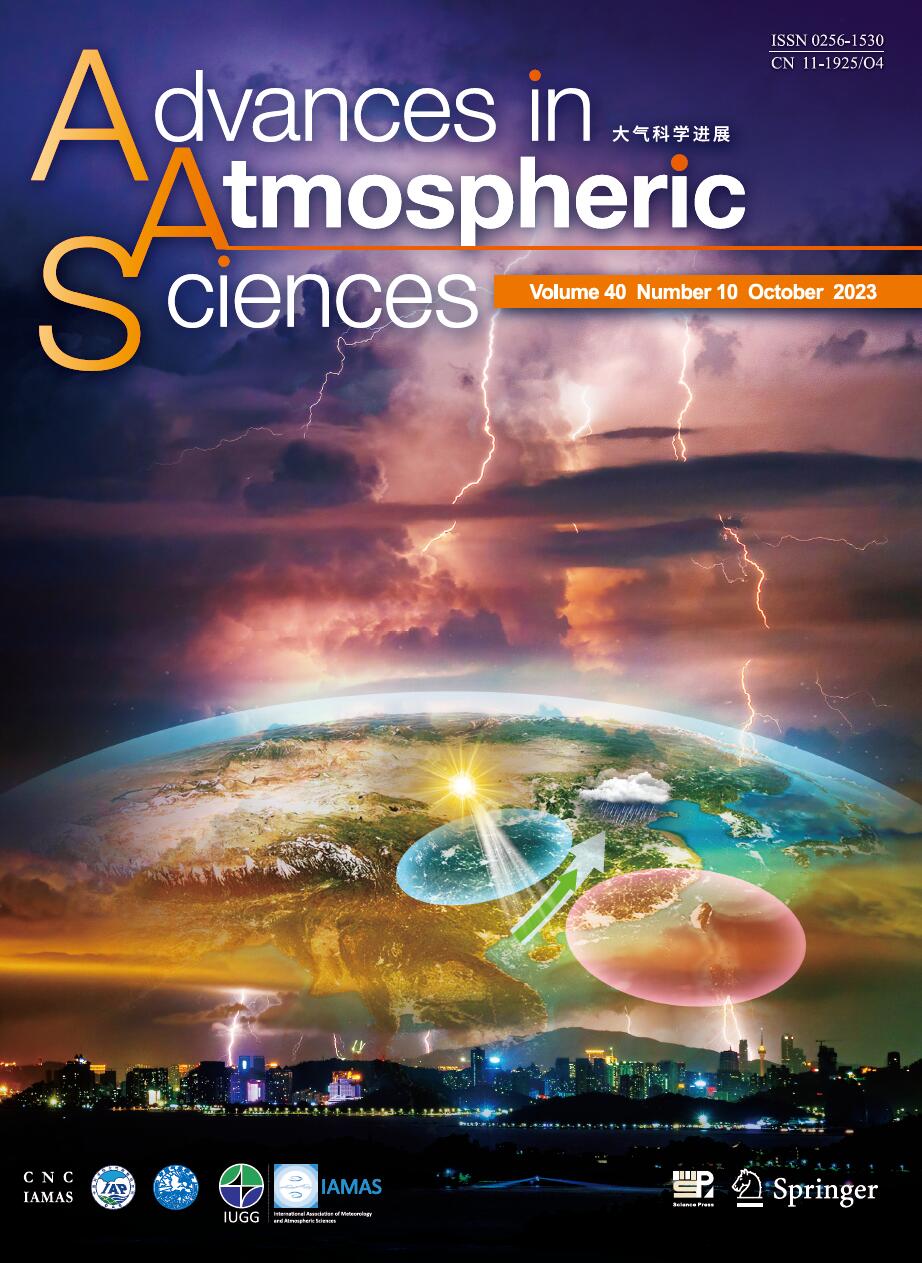| [1] |
Chen Qiying, Yu Yongqiang, Guo Yufu,
1997: Simulation of East Asian Summer Monsoon with IAP CGCM, ADVANCES IN ATMOSPHERIC SCIENCES, 14, 461-472.
doi: 10.1007/s00376-997-0064-3
|
| [2] |
He Jinhai, Zhou Xueming, Ye Rongsheng,
1995: Numerical Study of Ural Blocking High’s Effect Upon Asian Summer Monsoon Circulation and East China Flood and Drought, ADVANCES IN ATMOSPHERIC SCIENCES, 12, 361-370.
doi: 10.1007/BF02656985
|
| [3] |
Lin Zhaohui, Zeng Qingcun,
1997: Simulation of East Asian Summer Monsoon by Using an Improved AGCM, ADVANCES IN ATMOSPHERIC SCIENCES, 14, 513-526.
doi: 10.1007/s00376-997-0069-y
|
| [4] |
Cheng Anning, Chen Wen, Huang Ronghui,
1998: The Sensitivity of Numerical Simulation of the East Asian Monsoon to Different Cumulus Parameterization Schemes, ADVANCES IN ATMOSPHERIC SCIENCES, 15, 204-220.
doi: 10.1007/s00376-998-0040-6
|
| [5] |
Wei Helin, Wang Wei-Chyung,
1998: A Regional Climate Model Simulation of Summer Monsoon over East Asia: A Case Study of 1991 Flood in Yangtze-Huai River Valley, ADVANCES IN ATMOSPHERIC SCIENCES, 15, 489-509.
doi: 10.1007/s00376-998-0027-3
|
| [6] |
Min WEI,
2005: A Coupled Model Study on the Intensification of the Asian Summer Monsoon in IPCC SRES Scenarios, ADVANCES IN ATMOSPHERIC SCIENCES, 22, 798-806.
doi: 10.1007/BF02918680
|
| [7] |
Ji Liren, Sun Shuqing, Klaus Arpe, Lennart Benglsson,
1997: Model Study on the Interannual Variability of Asian Winter Monsoon and Its Influence, ADVANCES IN ATMOSPHERIC SCIENCES, 14, 1-22.
doi: 10.1007/s00376-997-0039-4
|
| [8] |
LI Qiaoping, DING Yihui, DONG Wenjie, YAN Guanhua,
2007: A Numerical Study on the Winter Monsoon and Cold Surge over East Asia, ADVANCES IN ATMOSPHERIC SCIENCES, 24, 664-678.
doi: 10.1007/s00376-007-0664-y
|
| [9] |
Yiran GUO, Jie CAO, Hui LI, Jian WANG, Yuchao DING,
2016: Simulation of the Interface between the Indian Summer Monsoon and the East Asian Summer Monsoon: Intercomparison between MPI-ESM and ECHAM5/MPI-OM, ADVANCES IN ATMOSPHERIC SCIENCES, 33, 294-308.
doi: 10.1007/s00376-015-5073-z
|
| [10] |
HAN Jinping, WANG Huijun,
2007: Interdecadal Variability of the East Asian Summer Monsoon in an AGCM, ADVANCES IN ATMOSPHERIC SCIENCES, 24, 808-818.
doi: 10.1007/s00376-007-0808-0
|
| [11] |
Ma Henian, Ding Yihui,
1997: The Present Status and Future of Research of the East Asian Monsoon, ADVANCES IN ATMOSPHERIC SCIENCES, 14, 125-140.
doi: 10.1007/s00376-997-0015-z
|
| [12] |
FENG Juan*, CHEN Wen,
2014: Interference of the East Asian Winter Monsoon in the Impact of ENSO on the East Asian Summer Monsoon in Decaying Phases, ADVANCES IN ATMOSPHERIC SCIENCES, 31, 344-354.
doi: 10.1007/s00376-013-3118-8
|
| [13] |
Chen Wen, Hans-F. Graf, Huang Ronghui,
2000: The Interannual Variability of East Asian Winter Monsoon and Its Relation to the Summer Monsoon, ADVANCES IN ATMOSPHERIC SCIENCES, 17, 48-60.
doi: 10.1007/s00376-000-0042-5
|
| [14] |
YAN Hongming, YANG Hui, YUAN Yuan, LI Chongyin,
2011: Relationship Between East Asian Winter Monsoon and Summer Monsoon, ADVANCES IN ATMOSPHERIC SCIENCES, 28, 1345-1356.
doi: 10.1007/s00376-011-0014-y
|
| [15] |
LIU Qianxia, ZHANG Meigen, WANG Bin,
2005: Simulation of Tropospheric Ozone with MOZART-2:An Evaluation Study over East Asia, ADVANCES IN ATMOSPHERIC SCIENCES, 22, 585-594.
doi: 10.1007/BF02918490
|
| [16] |
Zhu Qiangen, He Jinhai, Wang Panxing,
1986: A STUDY OF CIRCULATION DIFFERENCES BETWEEN EAST-ASIAN AND INDIAN SUMMER MONSOONS WITH THEIR INTERACTION, ADVANCES IN ATMOSPHERIC SCIENCES, 3, 466-477.
doi: 10.1007/BF02657936
|
| [17] |
LIU Huaqiang, SUN Zhaobo, WANG Ju, MIN Jinzhong,
2004: A Modeling Study of the Effects of Anomalous Snow Cover over the Tibetan Plateau upon the South Asian Summer Monsoon, ADVANCES IN ATMOSPHERIC SCIENCES, 21, 964-975.
doi: 10.1007/BF02915598
|
| [18] |
Ni Yunqi, Lin Yuanbi,
1990: Numerical Study for Characteristic Change of Asian Summer Monsoon Circulation and Its Influence Mechanism during the El Nino Period, ADVANCES IN ATMOSPHERIC SCIENCES, 7, 320-330.
doi: 10.1007/BF03179764
|
| [19] |
HUANG Ronghui, ZHOU Liantong, CHEN Wen,
2003: The Progresses of Recent Studies on the Variabilities of the East Asian Monsoon and Their Causes, ADVANCES IN ATMOSPHERIC SCIENCES, 20, 55-69.
doi: 10.1007/BF03342050
|
| [20] |
FU Jianjian, LI Shuanglin,
2013: The Influence of Regional SSTs on the Interdecadal Shift of the East Asian Summer Monsoon, ADVANCES IN ATMOSPHERIC SCIENCES, 30, 330-340.
doi: 10.1007/s00376-012-2062-3
|















 AAS Website
AAS Website 
 AAS WeChat
AAS WeChat 
 DownLoad:
DownLoad: